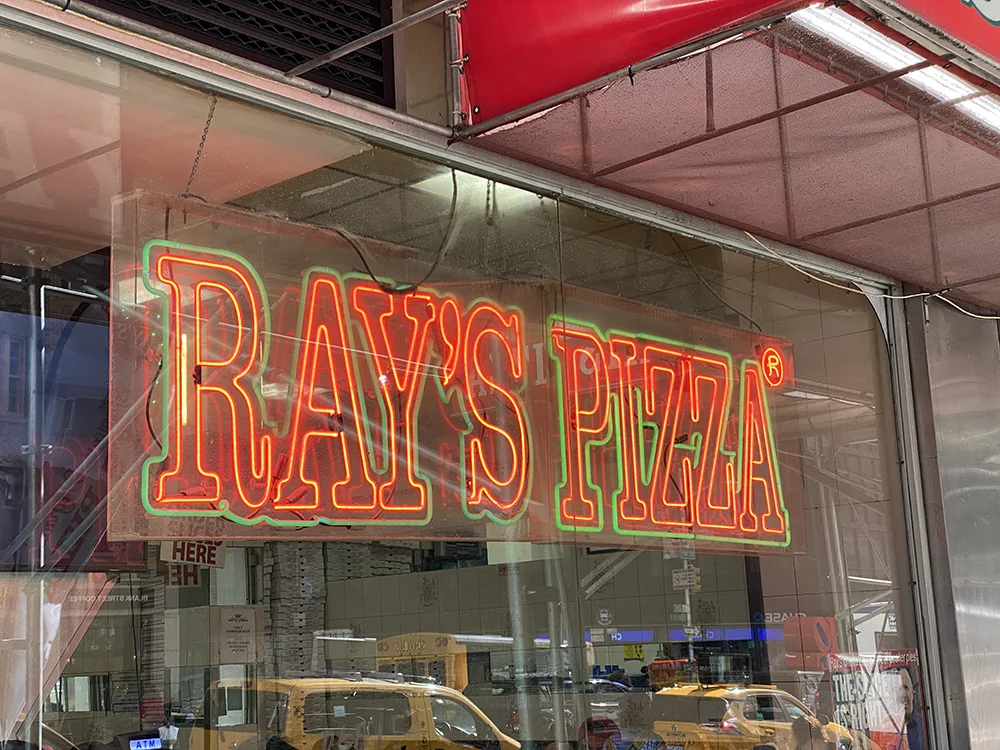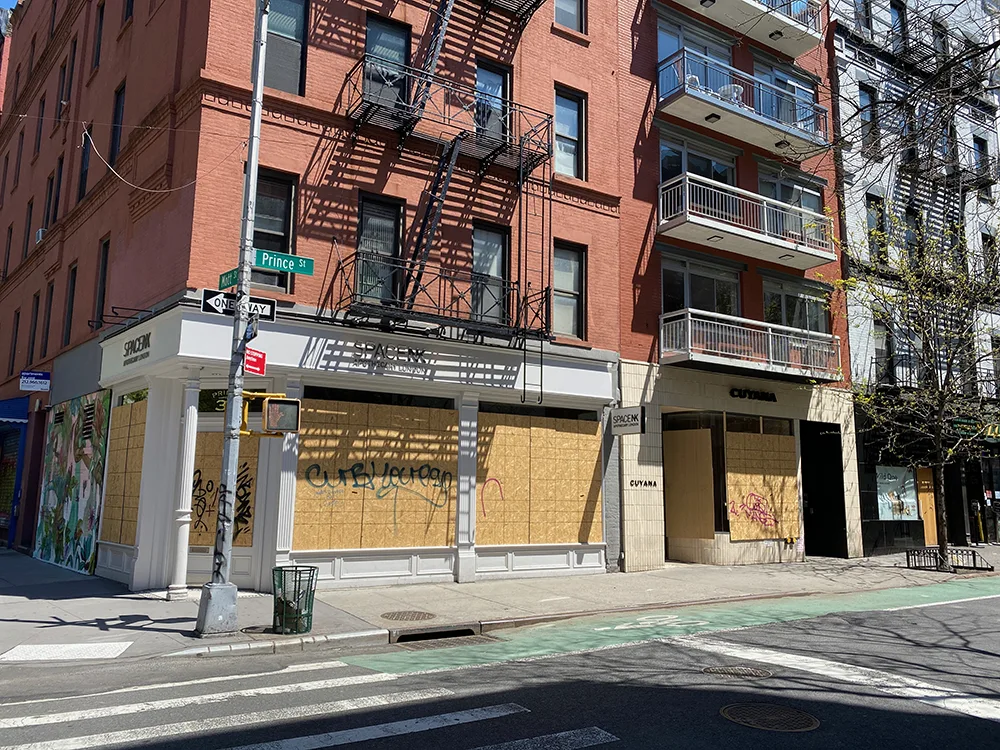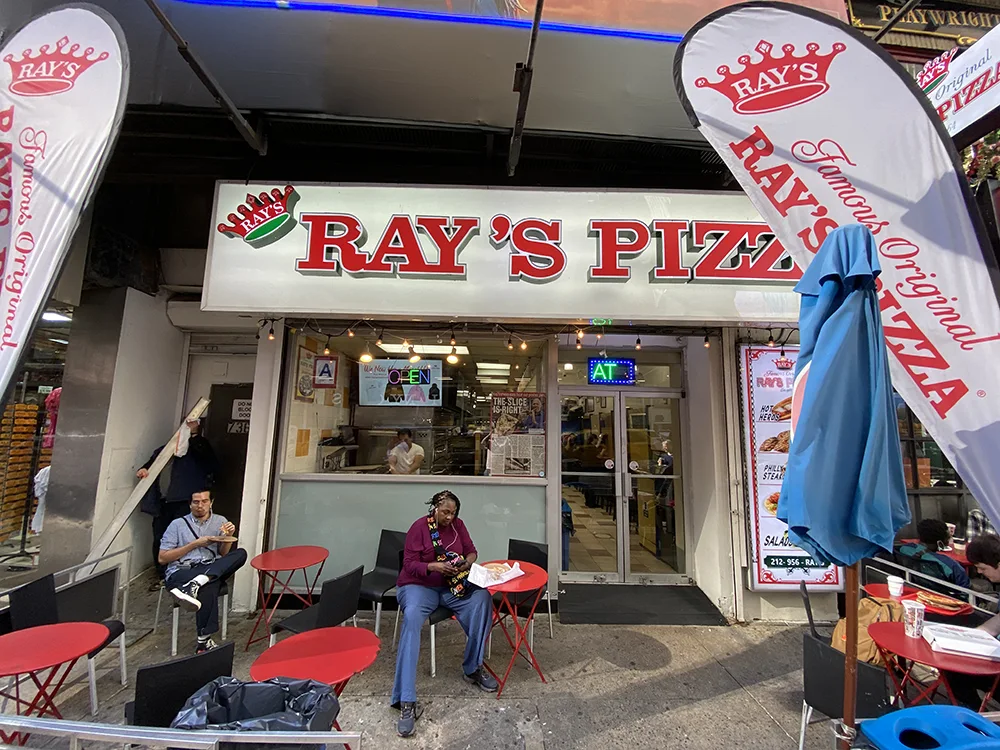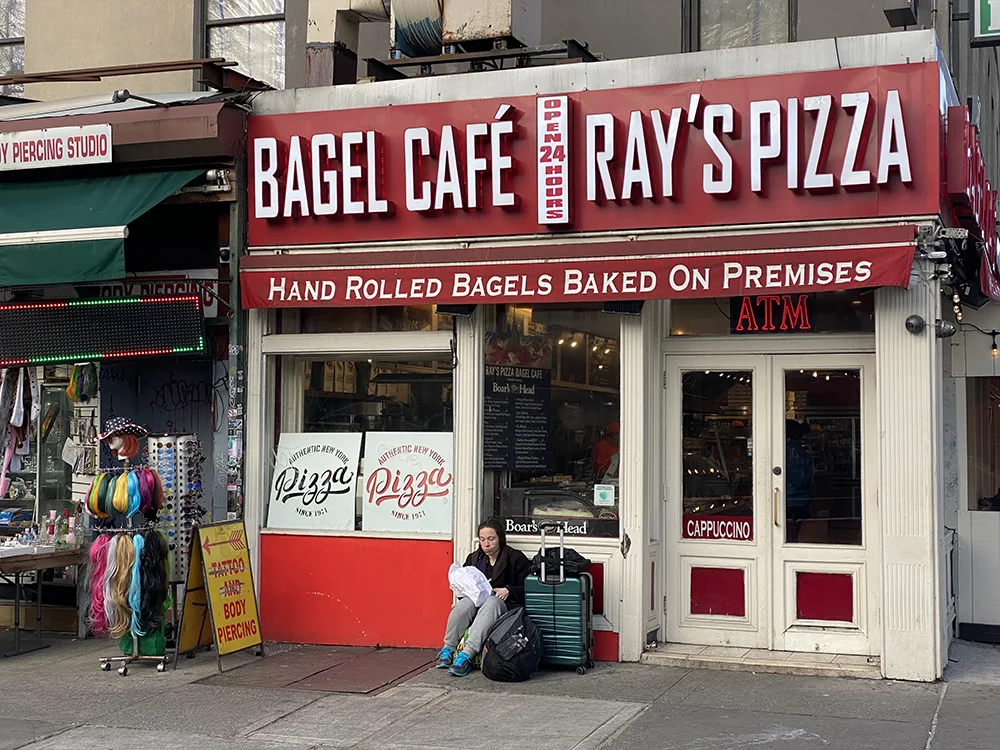Original, Famous, and Everything In Between: Ray’s, a Pizza Wars Story
By Ian MacAllen on Friday, August 9th, 2024 at 4:19 am | 4,126 views

Ray is a lie. There is no Ray, and there never was. But Ray’s Pizza, along with many variations on the name with superlatives like famous and original, became a New York institution. Ray’s Pizza has been copied, imitated, and mocked, launching one of the city’s many “pizza wars.” The resulting civil suits have become something of a legend all on their own.
Ray’s pizza, and its imitators, became so ubiquitous, the saga eventually landed as a joke on the hit television series Seinfeld. Kramer, lost in lower Manhattan, calls Jerry in a panic. He doesn’t know where he is, and can’t find his way home. Jerry asks him if he recognizes any landmarks, and Kramer sees a Ray’s pizza. Jerry asks if it’s Famous Rays. No, it’s Original Rays, according to Kramer. The first punchline: “famous original Rays?” No, just original, Kramer responds. By then there are more than three dozen pizza joints with some iteration of Ray in their name.
The origins of Ray’s pizza were intentionally muddled by these imitators. Strictly speaking, there was never a guy named Ray, but there was an original pizzeria with the name. The first Ray’s Pizza opened on Prince Street in 1959.
Ralph Cuomo lived in the tenement above Prince Street when he opened his pizzeria and an adjacent restaurant with the same name. Like so many pizza makers of the era, he relied on his mother’s recipes. He has famously explained why he called the pizzeria Ray’s – Ralph’s Pizza would have sounded too feminine, a fact repeated by nearly every news source written about restaurant.
Ralph did also go by the name “Rayfie,” which was then shortened to Ray, so while technically he was not named Ray, he was at least nominally known by the moniker. Cuomo also enjoyed cooking, a fact revealed some three decades later by a federal witness who testified Cuomo was often in the kitchen. But let’s not get ahead of ourselves.

The Ray’s Pizza on Prince Street might be the original shop using the name – The New York Times verified that Ray’s Pizza was listed in the 1960 telephone book (although not in the 1959 edition) – but that location was not Original Ray’s.
Like Ray’s Pizza, Original Ray’s is also not owned by anyone with the name Ray. Rosolino Mangano owned Original Ray’s, a shop Cuomo actually opened. Cuomo briefly operated a second Ray’s Pizza at 1073 First Avenue, but had other, more profitable business interests to attend to. He sold the second Ray’s Pizza to Frances Giaimo, who in turn sold it to Rosolino Mangano. That Original Ray’s at 1073 First Avenue is now a vacant storefront.
But by 1964, Mangano was operating Original Ray’s and opening other locations across the city.
Mangano also helped family and other immigrant friends open locations of Original Ray’s as well. They operated restaurants and Mangano offered assistance and branded them as Original Ray’s. It was like a small chain, but not actually a chain, a fact Mangano came to realize when some of his friends stopped paying him, and changed the name of their restaurants slightly.
Mangano began telling people he was named Ray, trying to erase Cuomo from the history of the restaurant. He also has claimed to have revolutionized New York Style pizza by displaying pizza in glass cases to showcase the variety of toppings, a standard practice in pizzerias in the city today.
Mangano eventually applied for federal trademarks on the name Ray’s and various descriptors as they relate to pizza. This decision was likely a direct result of the friends and relatives he had helped when they started creating variations on the name Ray and not paying Mangano anymore.
However, these original Ray’s pizza shops may not have ever become famous had it not been for Mario DiRienzo. If you haven’t guessed, DiRienzo opened the Famous Ray’s at 465 6th Avenue in the West Village. An immigrant from Roio del Sangro in Abruzzi, the name Ray was a nickname for his surname, but not actually his name.
While DiRienzo may not have been a real Ray, he was actually a famous chef. The New Yorker reported in 1976 that DiRienzo had been the chef at various embassies, including Italy’s embassy in London. DiRienzo’s pizza was not just your average slice at the time either, and he focused on higher quality ingredients. He eventually bought the building and remodeled it. Inevitable delays – has any construction in New York City been completed on time? – caused some anxiety, but he reopened to crowds nonetheless. Eventually, DiRienzo sold the Famous Ray’s restaurant, but held onto the building.
These three pizzaiolo are the origins of Ray’s, Original Ray’s and Famous Ray’s, with other Rays derivative of their shops. But that’s not the end of the Rays.
In 1973, Joseph Bari bought a Ray’s pizza on Third Avenue. He opened more locations including 930 Third Avenue, 1330 Third Avenue, and 128 West 72nd Street, as well as shops on Long Island. Bari, who immigrated from Sicily, registered the name Ray’s with the state of New York. He claimed this gave him the exclusive right to the name Ray, although this was not a federal trademark as he soon found out.
Bari, like Mangano, claimed to have invented the glass display case to show off pizzas. He also claimed to have innovated the use of paper plates. Somebody had to innovate that, right? Whether or not he “invented” using paper plates, his stores eventually became Ray Bari Pizza, the result of legal disputes over the name. Around 2007, Bari began contemplating an exit from the pizza business, and now all his pizzerias are closed.
However, perhaps the critical event in the history of the Ray’s pizza wars came in 1981 when Gary Esposito bought a Second Avenue Original Ray’s from Mangano. Like Bari, Esposito opened more locations across Long Island, and even into New Jersey. Esposito realized there was money in the pizza stand. He wanted to start a franchise system to license the name.

Unfortunately for Esposito, Mangano already owned trademarks on Ray’s, as well as other superlatives associated with it. Around the same time, Ralph Cuomo had begun to realize the name Ray’s had some value. Cuomo had previously been preoccupied running his own restaurant and a side business, but as the name grew famous, he too wanted to cash in. Cuomo, who also liked to gamble, probably needed the money.
After five years of legal fights, Mangano and Eposito formed a company to license a unified brand, logo, and style under the Famous Original Ray’s name. USA Famous Original Ray’s Licensing Corp then began filing lawsuits and forcing pizzerias across the tri-state area to become Famous Original Rays with standard branding, all for a fee. By 1999, the company had sued more than a dozen competitors, according to the New York Post, and continues to be litigious against pizzerias using the name Ray’s.
In 2011, Famous Ray’s, no longer operated by DiRienzo, was caught in the crossfire. The licensing corporation filed a million dollar lawsuit against Max Brothers, the operators of Famous Ray’s at the time. The 6th Avenue shop closed, with the promise of reopening as a licensed Famous Original Ray’s. The shop had brown paper covering the windows for weeks, but no Famous Original Ray’s ever opened.
That’s when Mario DiRienzo and his brother Lamberto returned to pizza making. A long-time resident of the West Village and by then in his 70s, DiRienzo opened Famous Roio’s, named for his hometown in 2012. A year later, the new shop had closed as well. The Famous pizza by then had a bad reputation, and the renovation of the shop didn’t do the location any favors, primarily scrubbing away the history. After Roio’s closed, it became Shu Han Ju, a Chinese restaurant, and now operates as Roma Pizza.

Famous Original Ray’s has filed suits against shops with names like Famous Ray’s Pizza Buffet, Ray’s and Son Pizza Restaurant, and Ray’s Pizza Bar. So far there are a few places that seem to have avoided the litigious corporation, like Ray’s Pizza & Bagel Cafe near Astor Place and Not Ray’s Pizza in Fort Greene.
New York City isn’t the only place with Ray’s imitators, such as Los Angeles where Rey’s Pizza can be found. Didier Tenenbaum, who owned and then sold a Canadian pizza chain, bought an existing pizzeria in L.A., Del-Cort Pizza. He wanted to make “New York Style” pizza, and rebranded the story as Rey’s, hoping the slight variation in letters would avoid any legal trouble.
Ralph Cuomo’s Ray’s Pizza shop closed in 2011 and half of it became the now famous and perhaps equally controversial Prince Street Pizza. Prince Street has become a tourist trap known for square slices, outspoken opposition to Mayor Bloomberg’s proposed soda tax, and racist online ranting. However, before closing, that original (lowercase) Ray’s pizza had become famous for more than just the pie.
In a classic pizzeria cliche, Ralph Cuomo was connected to organized crime. In the 1950s, before opening the restaurant, he had been arrested for holding up a nearby business. He spent some time in jail before returning home and opening the restaurant on the ground floor (ironically, in a not too dissimilar story from how Al’s Italian Beef was founded).
The pizzeria and a restaurant in the tenement building at 27 Prince Street shared a kitchen and for a time became known for its white pizza without tomatoes. The basement, notably filled with tree roots, became the hangout for a crew of organized crime members where they sorted drugs and cash. Cuomo himself was involved in moving the product. According to the New York Post, in 1969, Cuomo was found with $25 million worth of heroin in his car.
Cuomo was linked to the Luchese crime family, and his sister married Charles “Charlie Brody” DiPalermo, a ranking family member who was eventually arrested by Rudy Giuliani. Giuliani would eventually become mayor and lead a crusade against corruption surrounding the San Gennaro feast in Littly Italy.
Cuomo served time for the drugs found in the trunk of his car, but then went right back to the pizzeria. He also supposedly allowed drugs to be sold out of the storefront, which is perhaps why the first Ray’s pizza had little interest in building a pizza empire.
In the 1990s, Luchese crime family member Alfonso “Little Al” D’Arco turned state’s witness, and began spying on Cuomo and the Prince Street gang. According to Jerry Capeci and Tom Robbins, in their book Mob Boss: The Life of Little Al D’Arco, the Man Who Brought Down the Mafia, Cuomo still cooked in the kitchen despite his role in selling drugs.
With D’Arco’s testimony, Cuomo went to prison again. Cuomo often gambled, and always needed more cash from drug deals to fund his gambling. He eventually died in 2008 as a result of diabetes and heart problems.
His death was not the end of his legal problems, though. Cheryl Sorrentino, the daughter of DiPalermo, sued Cuomo’s estate. According to the New York Post, she claimed Lorraine Marini, Cuomo’s girlfriend at the time, and Helen Mistretta, his elderly cousin, had cheated Sorrentino out of an inheritance worth about one third of the estate.
Mistretta was still managing the restaurant two years later at the age of 80. That’s when the property and the business finally sold for just under $6 million.
Today, the only legal Ray’s are licensed shops bearing the name Famous Original Ray’s. The first Ray’s, the first Original Ray’s, and the first Famous Ray’s have all been closed, victims of rising rents, and a reminder that all good things, especially New York City real estate, must come to an end.

